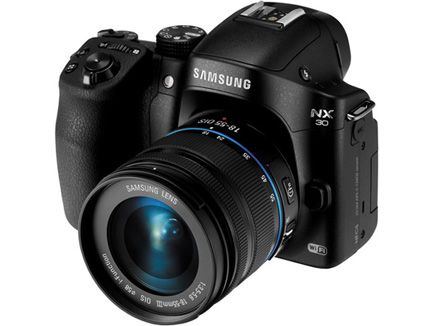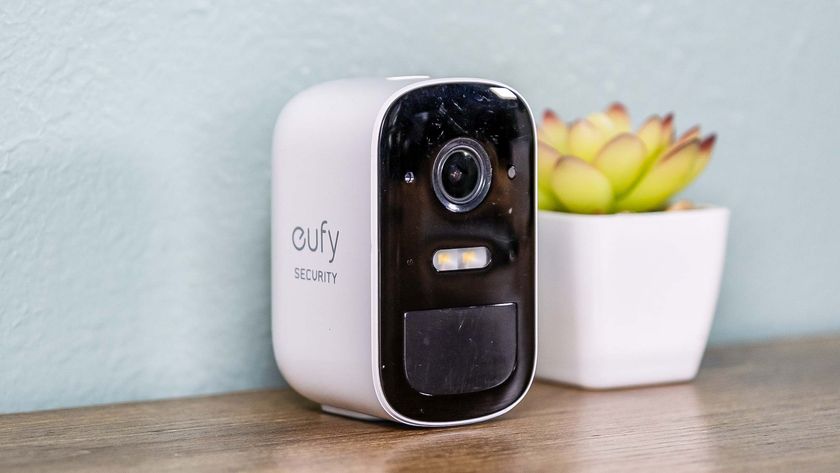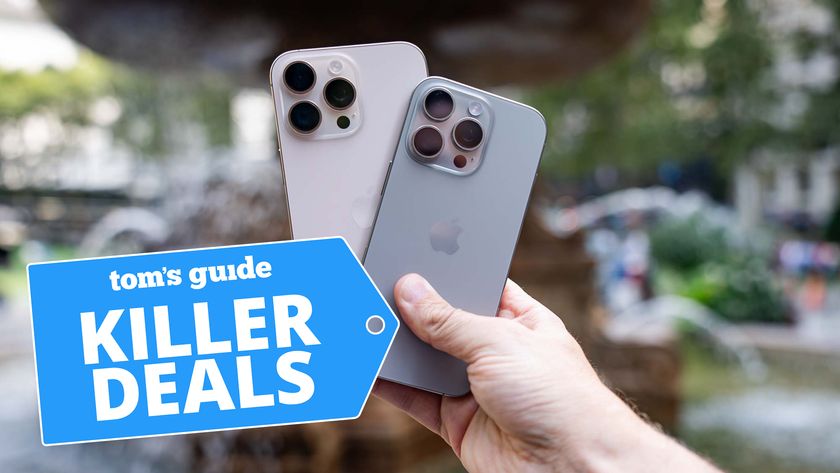Tom's Guide Verdict
With the look and feel of a DSLR, Samsung's NX30 packs mirrorless camera benefits, including rapid shooting and an innovative viewfinder.
Pros
- +
Sharp images with rich color and even exposure
- +
Easily accessible settings
- +
Sharp videos with clear sound
- +
Bright, articulating viewfinder
- +
Lightroom 5 editing software included
Cons
- -
A bit expensive compared to competitors
- -
Must buy camera with kit zoom lens
- -
JPEGs sometimes have too much contrast and noise reduction
Why you can trust Tom's Guide
Samsung's new NX30 sports a DSLR-like design, but this mirrorless camera offers several advantages over digital single-lens reflex cameras. These include a continuous-shooting mode of 9 frames per second and the ability to switch seamlessly from shooting stills to 1080p video and back again. The unique feature of the NX30 ($999, with 18mm-55mm lens) is its electronic viewfinder. The bright LCD eyepiece can tilt upward 90 degrees, which saves you from crouching if you are shooting something low to the ground. Plus, with its professional-quality photos, the camera's image quality rivals that of challengers like the Canon Digital Rebel T5i and Nikon D5300.
Design
Unlike many mirrorless cameras, including Samsung's own NX300, the NX30 eschews a slablike rangefinder design in favor of a bulky DSLR shape. In outward appearance, the NX30 is a nearly identical successor of Samsung's NX20 from 2012. Measuring 5 x 3.8 x 1.6 inches, the NX30 is a bit smaller than Canon's EOS M SL1 ($750, with zoom lens), which Canon bills as the world's smallest DSLR, at 4.6 x 3.6 x 2.7 inches. The NX30 body (without the lens) weighs 16 ounces, compared to the Canon's 14.4 ounces. We handed the NX30 to a professional fashion photographer, and she was surprised at how light it was.
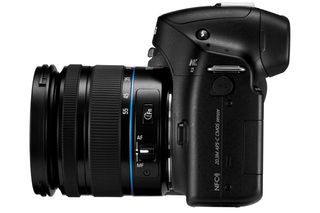
For performance, size and price range, the NX30 also rivals Canon's $850, 20.5-ounce Rebel T5i and Nikon's $900, 16.9-ounce D5300 (each priced with a bundled 18-55mm, optically stabilized lens, like the NX30). Both rivals boast articulating LCDs (Canon's is a touch-screen) that rotate up, down or face forward for selfies. The NX30's 3-inch, 1,037,000-dot screen is a Super AMOLED panel with touch-screen capabilities for things like changing settings or flipping through images of photos you've shot. The screen has full, rich color and is pretty bright, though it will wash out somewhat on a sunny afternoon.
MORE: DSLR vs. Mirrorles Cameras: Which is Better for You?
That's where the electronic viewfinder (EVF) comes in. Atop the central bump for the viewfinder is a pop-up flash, and above that, a hot shoe for attaching a larger external flash.
Electronic viewfinder
The EVF's 2,359-dot LCD is bright and detailed enough to not seem like a compromise compared to a DSLR's optical viewfinder — except for its sluggish refresh rate, which provides a choppy view if you are panning across a shot. (Samsung hasn't specified the viewfinder refresh rate.) The viewfinder has the unique ability to tilt upward, locking in three positions, up to 90 degrees. Overall, the EVF is a very handy feature that keeps you from crouching and allows you to capture semistealthy candids.
Controls
The NX30 has a conventional control layout similar to a DSLR's, with a shutter release, power switch and shooting-mode dial (Auto, Shutter Priority, Manual, etc.) on top of the right-hand grip. Behind the shutter release is a control dial for adjusting shutter or aperture, depending on the shooting mode, or for navigating through menus. A wheel on the back of the camera serves a similar purpose, allowing you to adjust shutter and aperture simultaneously in manual mode. The wheel also doubles as a four-way directional pad for accessing controls such as white balance and ISO settings.

A red button near where the right thumb rests activates video recording. Sunk into the soft-touch plastic, the button is hard to find by touch. You may miss some video opportunities as a result.

Handy touches include a button next to the shutter for changing the light-metering mode to optimize exposure according to what you are shooting. A customizable button on the back of the camera at the bottom right can be programmed to change the focusing mode. And a depth-of-field button next to the lens, and accessible by the right ring finger, can be reprogrammed for one-touch auto white-balance setting. These quick adjustment options could mean the difference between nailing a shot or not.
The NX30 scored very well on our test of accessibility to key settings.
| Setting | Steps/button presses | Function |
|---|---|---|
| Shutter | 1 | Length of exposure |
| Aperture | 1 | Amount of light let in |
| ISO | 1 | Point or points used for focus |
| Focus mode | 1* | Points or points used for focus |
| Light metering | 1 | Part of image with optimized exposure |
| White balance | 1 | part of image with optimized exposure |
| Exposure compensation | 2 | Set auto exposure to be darker or lighter |
| Wi-Fi sharing | 1 | Send images to smartphone, activate remote viewfinder |
| Video recording | 1 | Switch from photo to video and back |
| Play | 1 | View images or videos you've shot |
| Delete image | 3 | Self explanatory |
| Photo capture resolution | 3 | Number of megapixels |
| Photo capture quality | 3 | Amount of JPEG compression/detail, or RAW |
| Video capture resolution | 3 | Lines of resolution and frame rate |
| Video capture quality | 3 | Amount of compression/detail |
| Drive | 1 | Single photo,burst, timer, etc. |
| Row 16 - Cell 0 | Row 16 - Cell 1 | *If shortcut button is programmed |
Image quality
The NX30 doesn't just look the part of a midrange DSLR; it also delivers comparable photo quality. Overall, we found the detail and color to be excellent in both brightly lit environments and in dark settings.
To get comparable results, we test all mainstream DSLRs and mirrorless cameras —those with a so-called APS-C-size sensor — using a prime (nonzooming) lens of roughly a 32mm focal length. In this case, we chose Samsung's 30mm NX Pancake Lens, which sells for $300. We also spot-checked against Samsung's Compact 18-55mm Zoom Lens, which you (unfortunately) must buy bundled with the NX30. The 30mm is slightly sharper than the kit lens.
MORE: Best DSLRs
We also set the cameras to shoot the largest (in this case, 20.3 MP) and highest-quality JPEG files they are capable of and simultaneously capture uncompressed RAW data files, to see if flaws in the images are from the camera's components or its processing software.
Daylight results
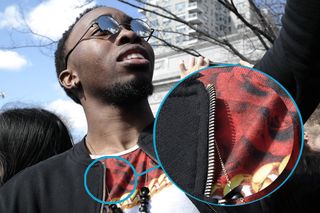
Images taken during the day were impressively sharp, colorful and well exposed. A photo shot in Washington Square Park in New York City shows every whisker and pore of a man taking a selfie during the city's annual pillow fight. Every thread in his shirt and sweatshirt is visible in a close-up, as well.

A photo of combatants in the fray is impressively sharp, considering the difficulty of focusing on people who are running around. However, some details are lightly smeared — not from movement, but from the camera smoothing out the noise (graininess) of shooting at the light-sensitivity level of ISO 640. (We needed that level to enable a fast 1/1,600-second shutter speed to freeze movement.) ISO 640 isn't terribly high, but it's already enough to cause loss of detail at least using the in-camera processing. You can set the level of noise reduction in the camera's menu, but we saw some smearing even at the lowest setting. Still, you wouldn't notice this much, unless you were making a poster-size print or radically cropping the photo.

The NX30's auto-exposure capabilities show up well in a photo of women in costume. The shadow under the cap of someone dressed like Nintendo's Luigi is bright enough to show her face clearly. And the bright sky overhead is light blue, not a blown-out white. Only the very brightest parts of the image, like another woman's cheek getting direct sunlight, are a bit overexposed.

Samsung's mirrorless camera produced excellent color as well. A photo of off-white china and silverware at a café, lit by sunlight from the window, was spot-on when shot using auto white balance. Our staff photographer said the image was up to professional standards.

We used the built-in flash to light up the faces of pillow-fight revelers standing with the sun partly behind them. It provided just enough brightness to match and supplement the afternoon sunlight around them.

For scenes with extreme differences between light and dark, the NX30 provides a high-dynamic range (HDR) mode that takes multiple photos at different exposure settings and merges them into one. We shot two adjacent buildings: an apartment tower in brilliant sunlight and an old church in the deep shadow of a nearby high rise. The church appeared nearly black in normal shooting mode but was perfectly visible in HDR mode, mimicking how it looked in real life.
Low-light results
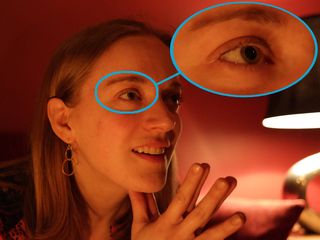
In our nighttime tests, we found the NX30 capable of producing pleasing images up to ISO 3200 in a photo of a friend by subtle lamplight. That's 32 times less light than at the camera's optimal, bright-light setting of ISO 100. It's also what we'd expect from a respectable midrange DSLR or mirrorless camera.
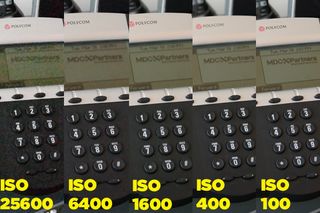
We don't recommend going above ISO 3200. By ISO 6400 (typically the next step up), not only was the graininess of so-called "luma" noise pronounced, but there were colored specs and splotches of what's known as "chroma" noise. Until recently, even the best cameras topped out at ISO 3200 or 6400. Newer cameras boast far higher specs but don't necessarily deliver attractive images.
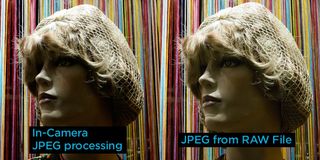
In low light, we noticed the NX30's tendency to render shadowy areas of images too dark, losing detail. In a nighttime photo of a shop window, for example, a mannequin's face is in deep shadow. But when we accessed the RAW files, we found much more light on the face. We were able to retain that light even after converting the file to a compressed JPEG using Adobe Photoshop Lightroom 5 (which Samsung Bundles with the NX30) in place of the camera's built-in image processor.
This loss of shadow detail wasn't a problem by bright light and was minor even in low light. But serious nighttime photographers may want to shoot in RAW, or simultaneous JPEG and RAW, to tweak images that come out with too much shadow.
Video quality
The NX30 is also formidable in shooting video, and features the ability to capture up to 1080p resolution at a brisk 60 frames per second for smooth motion. Nikon's D5300 matches that capability, while the Canon T5i tops out at 30 fps for 1080p video. Like the T5i and D5300, the NX30 includes built-in stereo microphones, as well as a jack for a higher-quality add-on mic. You can output video directly to a TV using the camera's microHDMI port.
Video shot at 1080p/60 fps of both the pillow fighters and a three-piece bluegrass band in the park was extremely sharp, and motion was smooth.
However, we did see more blown-out highlights in people's faces during the pillow fight. In a video of the band, what had been a light-blue sky showed up with a hint of lilac. That said, the strong sun would have posed problems for any video camera.
Audio quality for the camera's built-in mics was acceptable. All three instruments — a banjo, upright bass and fiddle — sounded clear. The singer's voice was a bit faint, but that's not surprising, given his distance from the camera and the loudness of the instruments.
The NX30 maintains focus well while shooting video. We captured children and their parents pushing a giant metal cube sculpture that rotates on its corner. The NX30 mostly stayed focused as the sculpture rotated and people walked around it.
Nighttime video performance was exceptional. In a walk down St. Mark's Place in the East Village, the camera rapidly adjusted exposure to the extremes of blazing-bright vendor stalls and the darker street, all the while capturing true-to-life color. The NX30's autofocus also kept pace, catching and staying on pedestrians as they walked towards the camera.
Autofocus and shooting speed
Autofocus is one of the capabilities that separate mediocre cameras from great ones. DSLRs traditionally excel here, because their mirror mechanism channels light into a special sensor that uses a very-fast focusing system called phase detection. The NX30, however, belongs to a new generation of mirrorless cameras that have phase-detecting pixels right on the image sensor — in theory, making its autofocus at least as fast as a DSLR's, and without the inconvenience of having to swing an internal mirror out of the way.
We don't have instruments precise enough to measure focusing speed. But we found the NX30 focusing time to be quite speedy — definitely on par with a DSLR.

Unlike a DSLR, whose screen is really only good for monitoring video or reviewing photos, a mirrorless camera provides a live preview of exactly what you are about to shoot. The NX30 allows you to snap a photo by simply tapping the touch screen right on the area on which you want to focus. With combatants scurrying around the park during the pillow fight, this was the only way to get a particular person we chose in focus.
MORE: Best Smartphone Cameras
Without having an internal mirror to move around, mirrorless cameras like the NX30 can shoot quite quickly. The NX30 manages a blistering 9 fps (RAW or full-resolution JPEG), which should be plenty fast enough to catch that split-second moment — say, when kids are playing, or people are smacking each other with pillows. In comparison, the Canon Rebel T51 and Nikon D5300 each shoot at 5 fps.
Wireless and GPS
The NX30 isn't equipped with GPS, but it offers several Wi-Fi connectivity options and makes them pretty easy to access. Turning the Mode dial to Wi-Fi brings up a menu with options, including MobileLink, Remote Viewfinder, Baby Monitor and Auto Backup.
The first two use the camera as a Wi-Fi hotspot that the smartphone logs in to, using the free Samsung Smart Camera App (Android and iOS) to enable the wireless features. Selecting MobileLink on the NX30's touch screen allows you to transfer photos from the camera (at full resolution or 2 MP) to a smartphone for reviewing and uploading. You can select images you have already taken or set the camera to automatically transfer new images as you shoot.

The Remote Viewfinder app allows the smartphone to act as a remote control. You can preview a shot on the smartphone screen and choose to capture it either as an image or a video. You can also make adjustments from the smartphone, including shutter speed, aperture, and image and video resolution.
The NX30 can connect to a home Wi-Fi network, allowing it to automatically back up images and videos to a computer on the network. It can also be set to automatically upload photos and videos to several online networks and cloud services — currently, Facebook, Picasa, YouTube, Dropbox and Flickr. Finally, the NX30 can act as an online baby monitor that you view and control using the free Samsung Home Monitor App for Android and iOS.
The wireless Share button next to the Shutter Release button is set by default to start the Autoshare app, but it can be set to instead trigger Remote Viewfinder, Baby Monitor or any of the other connected features.
Kit lens
The NX30 is bundled with an 18mm-55mm, f3.5-f5.6 kit lens with optical image stabilization. Canon's and Nikon's kit lenses have the same specs, but you have the option to purchase just their camera bodies if you already have lenses or prefer a different lens. Samsung's required bundling could be an annoying expense for people who don't want the kit lens.
Fortunately, the lens Samsung foists on you is a pretty good one. With a metal-alloy lens mount, it feels solid and has fairly smooth zoom and focus rings, though we did feel and hear them lightly grating at times.
Images are plenty sharp for entry-level shooters — though, as we noted, you could do better with the 30mm prime lens that we used for our testing. One feature we admired is the kit lens's near immunity to chromatic aberration (smears of color that result from shooting objects with sharp contrast or catching bright light from the edge of the frame in a night shot). We put Samsung's zoom through a cruel torture test of night shooting and only once got a tiny smudge of purple in a photo that no one with any sense of composition would try.
One plus of the Samsung kit lens is the iFn button on the barrel. Pressing it opens a quick-settings menu on the camera screen that makes it easy to change settings such as aperture, shutter speed, ISO and white balance.
Lenses and accessories
Samsung's accessories are comparatively inexpensive, making it easy for photographers to expand beyond the components that come in the box.
The 30mm, $300 prime lens we tested produced sharper images than the kit lens and has a good focal length for all-around shooting. Its flat "pancake" design makes the NX30 compact enough to fit into a large jacket pocket or a handbag.
Samsung has a decent assortment of about a dozen lenses (some in a choice of colors). They range from a 9mm pancake to a 18mm-200mm zoom, and include a lens that captures dual images for displaying in stereoscopic 3D on a compatible TV. Many of the lenses sell for less than $300, which is comparatively inexpensive. However, Samsung is introducing high-end models such as a $1,300 16mm-55mm zoom, the first in its "Premium S Lens" line.
Samsung sells four compatible external flashes, from two $150 compact models to a full-size $300 unit. Samsung offers only one external microphone — a compact, "gun"-style unit for $130 — but you can find plenty of other mics that fit the camera's standard 3.5mm input jack.
The NX30's best accessory is the bundled full copy of Adobe Photoshop Lightroom 5 — pro-level photo editing software that sells on it own for $150.
Bottom line
The outward appearance of the NX30 may not excite you, but the look of the photos and videos will. The camera captures extremely sharp images (especially with the right lens), with excellent, accurate color and even exposure. This high quality carries over to night shots, which looked comparatively clean up to a fairly high ISO of 3200. Video quality, while not quite as impressive as stills, is still solid and remarkably sharp. An intuitive design and control layout will allow you to make quick settings tweaks to get the best shot. At $1,000, the NX30 isn't cheap, but it delivers a lot for the money.
| Specs | Header Cell - Column 1 |
|---|---|
| Model name | Samsung NX30 |
| Megapixels | 20.3 |
| Type | Mirrorless |
| Price | $1000, with kit lens |
| Continuous shooting(with autofocus) | 9 fps, JPEG or RAW |
| Burst mode | 9 fps, full-sized JPEG or RAW |
| Sensor Type | APS, CMOS |
| Kit lens | 18-50mm f3.5-5.6, OIS |
| AF points and type | 105 phase-detection and 247 contrast-detection points |
| Shutter-speed range | 1/8,000–30 sec. |
| ISO range | 100 – 25,600 |
| Main video resolutions | 1080p, 720p and 480p at 30 or 60fps. |
| Video file format | MP4 (H.264) |
| Built-in flash | Yes |
| Hot shoe | Yes |
| Card type | SD |
| Ports | mic, HDMI-out, USB |
| Photos per charge | 360 |
| Video per charge | 145 min at 1080/60p |
| Wireless capabilities | Wi-Fi, NFC |
| Image stabilization | optical, in kit lens |
| Dimensions and weight | 5 inches x 3.8 inches x 1.6 inches, 16 ounces |
Follow Sean Captain @seancaptain and on Google+. Follow us @tomsguide, on Facebook and on Google+.
Sean Captain is a freelance technology and science writer, editor and photographer. At Tom's Guide, he has reviewed cameras, including most of Sony's Alpha A6000-series mirrorless cameras, as well as other photography-related content. He has also written for Fast Company, The New York Times, The Wall Street Journal, and Wired.
